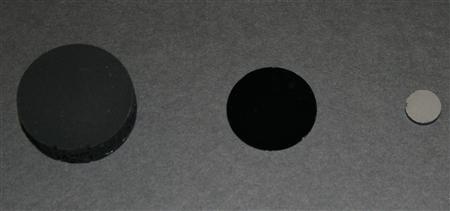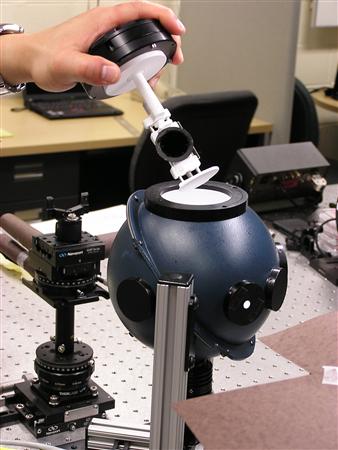Science Fiction
Dictionary
A B C D E F G H I J K L M N O P Q R S T U V W X Y Z
Carbon Nanotube Blackness Blacker Than Black

A material so black it has a reflective index of just 0.045 percent - three times blacker than the previous record holder? I apologize to readers who kept trying to get me to do this story; I'm slow.

(NIST reflectance standard owned, as my son would say)
In the above picture, you can see the National Institute of Standards and Technology reflectance standard (left), a sample of the new darkest material (center), and a piece of glassy carbon.

(NIST reflectance standard owned, as my son would say)
If you mount the carbon nanotube black material in the center of an integrating sphere (which measures the material's reflectivity), you discover that the material absorbs more than 99.9 percent of incident light.
So, how does it work?
It is composed of carbon nano-tubes, tiny tubes of tightly rolled carbon that are 400 hundred times smaller than the diameter of a strand of hair. The carbon helps absorb some of the light.These tubes are standing on end, much like a patch of grass. This arrangement traps light in the tiny gaps between the "blades."
The researchers have also made the surface of this carbon nano-tube carpet irregular and rough to cut down on reflectivity.
Science fiction writers have dreamed dreams of the blackest black. In his 1980 novel Restaurant at the End of the Universe, Douglas Adams decided it would make a perfect space ship coating.
It was a ship of classic, simple design, like a flattened salmon, twenty yards long, very clean, very sleek. There was just one remarkable thing about it.Update 10-Nov-2011: Here's an early reference to the idea of a "blacker than black" coating for materials; see the black coating from E.E. 'Doc Smith's 1939 novel Gray Lensman. Thanks to Winchell Chung of Project Rho for the tip on this item. End update."It's so... black!" said Ford Prefect. "You can hardly make out its shape... light just seems to fall into it!"
The blackness of it was so extreme that it was almost impossible to tell how close you were standing to it.
(Read more about Douglas Adams' Absolute Black)
If you enjoy true tales of black beyond black, take a look at Femtosecond Laser Pulse Turns Metals Pitch Black; what other sf writers have made use of the idea of absolute black?
Thanks to BajaB for the tip, as well as anonymous readers. Via New material pushes the boundary of blackness and Researchers develop darkest manmade material (press release).
Scroll down for more stories in the same category. (Story submitted 1/21/2008)
Follow this kind of news @Technovelgy.| Email | RSS | Blog It | Stumble | del.icio.us | Digg | Reddit |
Would
you like to contribute a story tip?
It's easy:
Get the URL of the story, and the related sf author, and add
it here.
Comment/Join discussion ( 2 )
Related News Stories - (" Material ")
Harvard Metamaterials Change Structure Instantly
'Annealed in any shape for a time, and codified, the structure of that shape is retained down to the molecules.' - Samuel R. Delany
Nano-Chainmail 2D Mechanically Interlocked Polymer
'Nemourlon armor of reasonable weight resists penetration by most fragments and any bullet that is not both reasonably heavy and fairly high-velocity.' - Jerry Pournelle, 1976.
Goldene - A Two-Dimensional Sheet Of Gold One Atom Thick
'Hasan always pitched a Gauzy - a one-molecule-layer tent, opaque, feather-light, and very tough.' - Roger Zelazny, 1966.
FlexRAM Liquid Metal RAM And One Particular SF Movie Robot
'Its lines wavered, flowed, and then painfully reformed.' - Philip K. Dick, 1957.
Technovelgy (that's tech-novel-gee!) is devoted to the creative science inventions and ideas of sf authors. Look for the Invention Category that interests you, the Glossary, the Invention Timeline, or see what's New.
Science Fiction
Timeline
1600-1899
1900-1939
1940's 1950's
1960's 1970's
1980's 1990's
2000's 2010's
Current News
Jetson ONE Air Races Begin, Can Air Polo Be Far Behind?
'If you're one of those rarities who haven't attended a rocket-polo "carnage", let me tell you it's a colorful affair.'
Will Space Stations Have Large Interior Spaces Again?
'They filed clumsily into the battleroom, like children in a swimming pool for the first time, clinging to the handholds along the side.'
Mornine Sales Robot
'Robot-salesmen were everywhere, gesturing...'
Bipedal Robot Floats Gently While Walking
'a walking balloon proceeded with long strides of its aluminum legs...'
Musk Idea Of Cars Talking To Each Other Predicted 70 Years Ago
'My cars talk to one another.'
Elegant Bivouac Shelter Produces Water And Electricity
'There was nowhere on the planet where science and technology could not provide one with a comfortable home...'
X-Control Janus-1 A Suitcase Aircraft
'You will notice that it... fits the suitcase nicely.'
'AI Assistants' Are Actually Less Reliable For News
'Most men updated their PIP on New Year's Day...'
YES!! Remote Teleoperated Robots predicted by Technovelgy!
'...a misshapen, many-tentacled thing about twice the size of a man.'
Will Robots Ever Fold Landry?
Where have you gone, Mrs. Robinson?
Will AIs Give Better Results If You're Rude To Them?
'I said, "Listen up, motherf*cker.'
Cybertruck Robotic Arm F10 Drone Launch!
Drone away!
Black Fungus Blocks Radiation
'You were surrounded by Astrophage most of the time'
Liuzhi Process Now In Use In China
'He was in a high-ceilinged windowless cell with walls of glittering white porcelain.'
Reflect Orbital Offers 'Sunlight on Demand' And Light Pollution
'I don't have to tell you about the seven two-mile-diameter orbital mirrors...'
Will Robots Become Family Caregivers?
'The robant and the tiny old woman entered the control room slowly...'
